In case you have not yet seen it, I thought I would draw your attention to (what is currently) the most recent issue of the American Mathematical Monthly, and, in particular, the article:
Leinster, T. Rethinking Set Theory. The American Mathematical Monthly, 121(5), pp. 403-415.
An arXiv version can be found here.
The abstract says:
Mathematicians manipulate sets with confidence almost every day, rarely making mistakes. Few of us, however, could accurately quote what are often referred to as 'the' axioms of set theory. This suggests that we all carry around with us, perhaps subconsciously, a reliable body of operating principles for manipulating sets. What if we were to take some of those principles and adopt them as our axioms instead? The message of this article is that this can be done, in a simple, practical way (due to Lawvere). The resulting axioms are ten thoroughly mundane statements about sets.
In particular, the ten axioms (stated informally) are:

Leinster makes it a point to dispel a few misconceptions about Lawvere's presentation, namely, (1) that an underlying goal is to replace set theory with category theory; (2) that the axiomatization requires greater mathematical maturity than other systems (e.g., ZFC); and (3) that there might be some inherent circularity by mentioning both 'categories' and 'sets'.
(Respectively, he comments: this is literally set theory; it is not that complex; and the word 'category' is not used.)
The primary motivation for this paper is that most working mathematicians use ZFC set theory without really paying attention to the axioms. As the author somewhat humorously remarks:

The article does mention some pros and cons of using the text to teach "axiomatic set theory," but perhaps they could transfer to a bridge course:

The citations above are:
(5) F. W. Lawvere, R. Rosebrugh, Sets for Mathematics. Cambridge University Press, Cambridge, 2003.
(18) T. Trimble, ETCS: building joins and coproducts (2008). Retrieved online from http://ncatlab.org/nlab/show/Trimble+on+ETCS+III.
Still: If you are interested in trying this text for a bridging course, then maybe using Leinster's presentation would be of help. (Or reading it over, making it available for students, etc.)
(As a final, offhand comment about bridging courses: You can find more on the history of such courses at my MO response here.)


